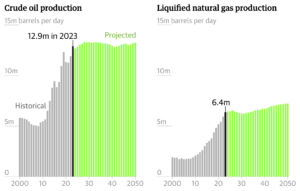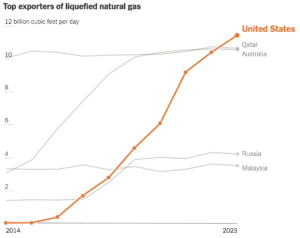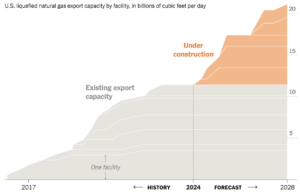USA plans to maintain high levels of oil and gas production until at least 2050 – so it can export freedom. Healthy ecosystems require integrity, not just biodiversity. Endangered slug runs circles around arty rivals.
US oil and gas production has peaked and is staying high
The USA is the world’s leading producer of oil and gas. Crude oil production has increased 2.5-fold since 2008 and liquified natural gas (LNG) production has more than trebled in that time. That’s Major Problem Number 1. But MPN1 is now history.
Major Problem Number 2 is that the USA’s production of both oil and gas is expected to remain at peak levels until not 2030, not even 2040, but until 2050.

So, what is the USA doing with all this gas? Well, for several years those two great soccer playing nations Qatar (newly crowned Asian Champions) and Australia (sent packing early) have battled it out for the LNG Exporter’s World Cup. However, over the last eight years the USA has gone from not even bothering to complete the entry form to being crowned World Champions (graph below). About two-thirds of the USA’s exported LNG currently ends up in Europe and a quarter goes to Asia but that is likely to reverse in coming years. The USA’s gas dominance is built on fracking shale beds which was developed as a commercially viable technology in the 2000s.

President Biden recently announced a ‘pause’ on approvals for proposed LNG export projects – a policy that will no doubt be rescinded the day a future President Trump assumes office. But, pause or no pause, the developments that are already approved and in the pipeline (so to speak) are set to almost double LNG exports over the next four years.

All in all, yet more reasons to conclude it’s ludicrous to think that global greenhouse gas emissions are going to decline rapidly in the next six years to keep warming under 1.5oC, or even 2oC.
As an aside, the motivations behind Biden’s decision are rather unclear. Was it to speed the phase out of fossil fuels and reduce greenhouse gas (GHG) emissions? (Will it reduce GHGs anyway?) Was it because the supply of LNG is likely soon to exceed demand globally? Was it to keep down the price of gas for the USA’s domestic consumers? Was it to attract young and environmentally conscious voters in an election year?
Freeport, TX exports molecules of US freedom
Biden’s recent surprise aside, a useful insight into the USA’s motivations for increasing the production and export of gas is to be found in a 2019 press release from the US Department of Energy regarding the approval of a fourth LNG export facility in Freeport, Texas. The minute required to read the Department’s bluster is a worthwhile investment but here are a few snippets:
‘Increasing export capacity is critical to spreading freedom gas throughout the world by giving America’s allies a diverse and affordable source of clean energy [furthering] this Administration’s commitment to promoting energy security and diversity worldwide.’ (Decoded: global energy dominance is central to the USA’s policy of continuous economic growth and perpetuates US global supremacy by increasing other nations’ dependence on US fossil fuels and eliminating their own recent dependence on imported fuels.)
‘Approval furthers this Administration’s commitment to promoting American energy, American jobs, and the American economy.’ (Decoded: screw the rest of the world, screw the environment, American exceptionalism rules.)
‘The Department of Energy is doing what it can to allow molecules of U.S. freedom to be exported to the world.’ (You can take a short break at this point to vomit if you wish.)
‘Freedom gas’ and ‘molecules of U.S. freedom’!! Where are you when we need you, George?
Ecosystem integrity
We are all familiar with the concept of biodiversity nowadays, and many of us are concerned about its loss. However, I don’t think that ‘ecosystem integrity’ has yet made its way into the public consciousness.
Ecosystem integrity is broader than just biodiversity – its elements can be characterised as a system’s composition, structure, function and stability.
A forest, for instance, has high ecosystem integrity if it has:
- All its original biodiversity.
- Healthy species populations.
- Its original vegetation structure.
- Stability over long time periods.
A forest with high ecosystem integrity is a complex adaptive system that works through feedback loops to maintain its integrity by adapting to, resisting and bouncing back from natural disturbances (for instance, evolutionary developments, infections and cyclones). It is also well placed to maintain the natural processes that provide important benefits to humans – for instance, absorbing carbon from the atmosphere and storing it for long periods, filtering freshwater, and regulating regional rainfall.
It will come as no surprise that a naturally regenerating forest of native species that has not been disturbed by humans (i.e., a primary forest) has high system integrity, whereas a commercial plantation of one or two species of non-native trees that are regularly harvested for timber, pulp, oil, etc., has very low ecosystem integrity.
The protection and restoration of ecosystem integrity is essential for all land-, coastal- and marine-based ecosystems and for human health and survival. High integrity ecosystems that have great biodiversity and store lots of carbon, for instance but not only primary forests, should be prioritised as further losses make it even more unlikely that we will halt the loss of biodiversity and keep global warming under 1.5oC. Priority should be placed on the protection of high integrity ecosystems, and where necessary restoration of damaged ones, with an emphasis on promoting connectivity at the landscape scale and avoiding the creation of scattered patches. All the while, supporting the rights and livelihoods of indigenous peoples and local communities.
To give a current local flavour to this, Geraldine Brooks wrote a heartfelt op-ed in the Sydney Morning Herald this week appealing to Minister Plibersek to reject a proposal to clear almost 3km2 of primary forest in Tasmania’s Takanya/Tarkine wilderness. Clear the old growth trees and destroy the habitat for what? To build an even bigger toxic tailings dam for a copper, zinc, lead, silver and gold mine.
Convert forest exploiters into forest managers
Understandably and rightly, considerable public and political attention is directed at reducing the deforestation of primary forests. However, the rates of forest degradation from selective logging for timber and pulp (‘harvesting’) far exceed the rates of total deforestation, but despite this the problems associated with forest degradation are paid relatively little attention. Given the scope and severity of the problems – greatly reduced ecosystem integrity, reduced long term storage of carbon in big old trees and the soil, the release of CO2 into the atmosphere, and increased susceptibility to fire and invasive species – it is not surprising that these ‘production forests’ often prove to be unsustainable from a commercial as well as an environmental standpoint.
Five mechanisms have been proposed to improve the management of degraded tropical forests, particularly with a view to increasing CO2 removal, decreasing CO2 emissions, reducing soil erosion and protecting remaining biodiversity:
- Implement reduced-impact logging practices that reduce carbon emissions and maintain timber yields. This requires well-trained forestry workers and auditors.
- Use more of the wood that is in felled trees.
- Reduce the frequency of harvesting and lower logging intensity. This retains carbon and increases the timber yield once the changes have been established.
- Remove lianas from infested trees to promote the growth of young trees.
- Plant trees in areas that are severely degraded, lack the ability to regenerate naturally and are easily accessible so that the trees can be tended after during their early years.
The reality is that selective logging is not going away any time soon and the proposed goal is to ‘convert forest exploiters into forest managers’. Health workers will recognise this as a ‘harm reduction’ approach: accepting that the ideal (e.g., immediate cessation of selective logging, particularly in new areas) is unachievable in the foreseeable future and doing what one can in the meantime to reduce the damage.
Hug the slug
Almost 7,000 young artists submitted entries for the 2023 Australian Conservation Foundation’s Wild At Art competition. The competition gives young people the opportunity to draw attention to Australia’s threatened plants and animals. Griffin Hincksman was awarded first place in the Most Unusual Artwork category for his composition focusing on the giant Kaputar slug which … well, I’ll let Griffin himself tell you:
‘I have chosen this animal because it is big and cute. It is also a slug and most people think ew or yuck when they think of slugs, but I thought that it was the perfect thing to make an artwork on. It is an endangered species that lives on an extinct volcano in North-west NSW. The volcano is called Mount Kaputar which has lots of other endangered species. The slug is a part of a unique group of unusual animals known as the Mount Kaputar Land Snail and Slug Threatened Ecological Community. This slug is around 30cm big! But in my artwork I have made a few smaller ones. If you look really closely at the artwork you will see a secret word or symbol. I have made my artwork out of Fimo Clay and glued it onto a wooden board. It also has a frame around it.’

Peter Sainsbury is a retired public health worker with a long interest in social policy, particularly social justice, and now focusing on climate change and environmental sustainability. He is extremely pessimistic about the world avoiding catastrophic global warming.

